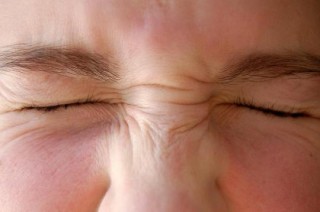Saturday, June 7, 2014
What the Things You See When You Rub Your Eyes Are Called
Do you like this story?

Today I found out what the things you see when you close your eyes and rub them hard are called, namely “phosphenes”.
A phosphene is characterized by perceiving some form of light when there is little or no light actually entering the eye, making it an entopic phenomenon (meaning the source of the phenomenon is within the eye itself). Phosphenes are most commonly introduced by simply closing your eyes and rubbing them or squeezing them shut, tightly; generally the harder you rub or squeeze, the more phosphenes you’ll see. This pressure stimulates the cells of the retina and, thus, makes your brain think you are seeing light. Specifically, Grüsser et al. demonstrated that pressure in the eye results in activation of retinal ganglion cells in a very similar way to how they activate as a response to light.
There are also several other ways phosphenes can be generated. These include through: electrical stimulation; intense magnetic fields; hallucinogenic drugs (phosphenes not to be confused with hallucinations, which are generated in the brain, not the eye); a blow to the head or a particularly severe sneeze where extra pressure is created in the eye on the retina and possible stimulation of the visual cortex; low blood pressure, which can be experienced if you stand up really fast after you’ve been relaxing; exposure to radiation; meditation or extended visual sensory deprivation; various side effects from medical drugs; and certain diseases of the retina and nerves.
The word “phosphene” was coined by surgeon JBH Savigny deriving from the Greek “phos”, meaning “light”, and “phainein”, meaning “to show”.
Bonus Facts:
- When phosphenes show up during meditation, they are more commonly known as “nimitta”. In Buddhist psychology and philosophy, this simply refers to forms, shapes, colors, sounds, etc. perceived during meditation. Prisoners who are being sensory deprived also occasionally will experience this phenomenon; in this case, it is often called “prisoner’s cinema”.
- A phosphene is not to be confused with phosphine, which is a toxic and explosive gas.
- The first documented electrically produced phosphenes were by neurologist Otfrid Foerster in 1929. The first documented reference to any type of phosphene goes back all the way to the ancient Greeks, though they didn’t call them phosphenes obviously.
- Scientists Brindley and Rushton, in 1974, once successfully created a type of visual prosthesis that allowed certain blind people to see Braille spots using phosphenes. This device only works on blind people whose brains were capable of processing visual information, such as those who once could see, but lost their sight in an accident or the like. More recently, researchers have successfully developed brain-computer interfaces for certain blind people that create phosphenes such that it mimics what the person would see, if their eyes worked, so somewhat restoring their vision. Both these visual prosthesis work through electrically produced phosphenes.
Subscribe to:
Post Comments (Atom)


0 Responses to “What the Things You See When You Rub Your Eyes Are Called”
Post a Comment